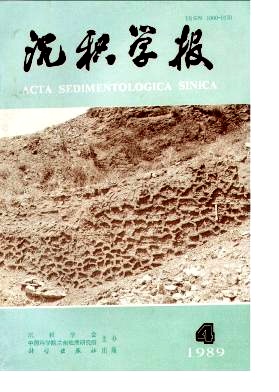Li Renwei, Xin Maoan. ORIGIN OF EVAPORITES OF DONGPU BASIN[J]. Acta Sedimentologica Sinica, 1989, 7(4): 141-148.
| Citation:
|
Li Renwei, Xin Maoan. ORIGIN OF EVAPORITES OF DONGPU BASIN[J]. Acta Sedimentologica Sinica, 1989, 7(4): 141-148.
|
ORIGIN OF EVAPORITES OF DONGPU BASIN
- 1.
Institute of Geology, Acadcmia Sinica;
- 2.
Research Centre of Zhong Yuan Oil Field, Hcnan Province
- Received Date: 1986-02-07
- Publish Date:
1989-12-10
-
Abstract
Dongpu basin is located in the North-Eastern Part of Henan Province and South-Western part of Shandong Province, with area of 5300km2. It started with intensive fault-subsiding activities at the end of the Mesozoic era. During Lower Tertiary, clastic rocks and evaporites with thickness of 7000m deposited in Shahejie group and Dongying group. There are four suits of evaporitc deposits in the Lower Tertiary Shahejie group of Dongpu basin. Three of thera occur in third member of the group. Three of them occur in third member of the group, the another occurs in first member of the broup. Evaporites localize generally near the centre of a sub-subsidence. Their total thickness onrmally is ca. 100-200ra, sometimes up to 400m. Evaporites of Dongpu basin are mainly halites, anhydrtes and rairabilite-glauberite rocks. Their raineralogical composition varies greatly iaterally and longitudinally. In addition to existence of minerals such as mirabilite-glauberite the mineralogical composition of the evaporites may display a certain significance to its origin. The bromine distribution in halites of Dongpu basin was studied. It has been discouvered that all samples have low values below 30 ppm, which are much lower than those of normally marine halites. The bromine contents in some samples of halites are approximate to or below IOppm, which indicates not only that the halites are second-cycled in origin but also that the secod-cycled halites are probably from non-marine or continental fresh water. At a certain geological tiem, sulfur isotope composition of marine evaporites and the correspondent sulfates of ancient oceans changes generally in a narrow range. δS34Valucs (‰) of the present marine evaporites and the oceanic sulfates are +20, more or less. There is no distinct difference in sulfur isotope composition of marine evaporites between the Tertiary and the present. However, it has been shown by determination of sulfur isotope composition of anhydrites from Dongpu basin, that their δS34 Valucs are from +33.1 to 37.5 and the sulfur is much enriched in S34 Corapared with the Tertiary marine type. So it is difficult to suggest that the anhydrites of Dongpu basin are typically marine in origin. Generally, only a difined amount of sulfates are contained within water body of a quite closed inland basin. Biological fractionation caused by reducing bacteria may change the original sulfer isotope composition greatly, finally the S34 is most enriched in sulfate deposites. The Dongpu basin would be such closed type of lake basins and the evaporites, enriched in S34, deposited in it correspondently. Similar to lake basins, e.g. Uintah basin Utah etc., consisting of the Green River Formation, probably the Dongpu basin experienced steps when the water body was chemically stratified. A strong fractionation of sulfur isotope occured and the chemically stratified structure in water body favoured accumulation of orgainc niattdr to produce a enormous potential of oils and gas in the basin.
-
References
|
[1]
|
金强,黄醒汉,1985,华东石油学院学报(自然科技版),9卷1期1 一 14页。br> |
|
[2]
|
B·A·格里年科,L·H格里年科(赵瑞译)1980,硫同位素地球化学,北京科学出版社 |
|
[3]
|
R.D.Cole and M.D.Picard, 1978, Geological Society of America Bull., V.89, p.144-1454. |
|
[4]
|
R.D.Cole and M.D.Picard, 1981, Sulfur-isotope variations in marginal-lacustrine rocks of the Green River Formation, Colorado and Utah, SEPM Special Publication No. 31,p.261-275 |
|
[5]
|
G.A.Desborough. 1978. Geological Social Society of America Bull., V.89 p.961-971. |
|
[6]
|
H. P. Eugster, 1980, Geochemistry of evaporite lacustrine deposits, Ann. Rev. Earth,Plannet. Sci. 8: 35-63 |
|
[7]
|
G.Faure 1977, Principles of Isotope Geology. John Wiley & Sons, New York. |
|
[8]
|
A.G.Harrison and H.G.Thode, 1985. AAPG Bull., V.42. p.2642-2644 |
|
[9]
|
W.T.Holser. 1979a, Mineralogical Socicly of America Short Course Noics, V.6, p.21l-286. |
|
[10]
|
W.THolscr, 1979b, Trace clcmcms and isotopes in evapontcs, ibid. p.295-346 |
|
[11]
|
W.T.Holser and T R.Kaplan. 1966, Chem. Geol.. V.l, p.93-135 |
|
[12]
|
C.K.W ilgas and W.T Holser. 1984, AAPG Bull., V.68, p.765-767 |
-
-
Proportional views

-






 DownLoad:
DownLoad: